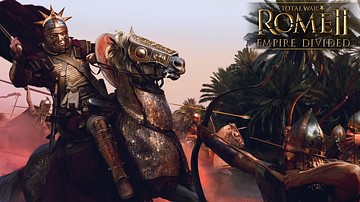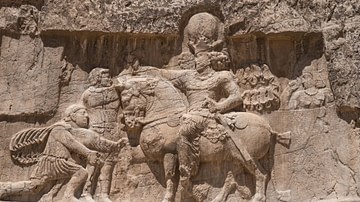The Historia Augusta (Great History) is a Latin work of the 4th century CE that chronicles the lives of Roman emperors from 117-285 CE. Among the many stories related is the history of Zenobia of Palmyra and her challenge to Roman authority which was crushed by the emperor Aurelian in 273 CE.
Zenobia (b. 240 CE, death date unknown) was the wife of the Syrian governor and founder of the Palmyrene Kingdom, Odaenathus (r. 263-267 CE) who was killed (or intentionally assassinated) on a hunting trip in 267 CE, leaving his young son Vaballathus (b. 259 CE, d. c. 273 CE) as successor. As Vaballathus was too young to reign at the time, Zenobia became regent for their son and expanded the kingdom of Palmyra into an empire.
Her rise to power took place during the chaotic period known as the Crisis of the Third Century (235- 284 CE, also known as the Imperial Crisis) when the central government was weak and various Barracks Emperors succeeded each other rapidly in rule. In this climate, no one noticed - or had the power to deal with - Zenobia's steady expansion of power until Aurelian (r. 270 - 275 CE) came to power and ended her ambitions, drawing the Palmyrene Empire back under the control of Rome. The story of Zenobia's rise and fall is given in a number of ancient works and, among them, is the Historia Augusta.
Historicity of Historia Augusta
While today the Historia Augusta is recognized as largely fictional (some scholars even giving it the label of "historical fiction"), it was considered reliable history in its time and for many centuries afterwards. The famous historian Edward Gibbon (l. 1737-1794 CE) accepted it as an authentic record of the ancient Roman history and relied on it extensively in his six-volume work The History of the Decline and Fall of the Roman Empire which, like the Historia Augusta, is largely viewed as inaccurate in the modern day. Both of these works, however, had significant impact on the audiences who read them or heard them read.
Rather than regard Historia Augusta as largely fictional, it would perhaps be better to consider it in the same light as one would the genre of ancient Mesopotamian naru literature. Naru literature began appearing around the second millennium BCE in Mesopotamia and is characterized by stories featuring a well-known figure from the past (usually a king) as the main character in a quasi-historical tale, which either extolled the king's military prowess, told the tale of his life and reign, or, more often, used the king to exemplify the proper relationship between human beings and the gods. The main character (king) was always an actual historical figure, but the story was either fictional or slanted in a particular way in order to achieve a desired impression.

While the Historia Augusta is not as concerned with the gods as it is with the Roman emperors, the same paradigm applies in that the tales of the Roman rulers are given as "teaching moments" through which one learns what it means to be a good monarch or a poor one, a great man or a failure. The work is certainly biased in its presentation but is understood to have drawn on reliable historical sources for its narratives. The focus of these narratives, however, is always on how effective - or paltry - a given emperor's reign was understood to have been. This model applies not only to the Roman emperors, however, but also to their adversaries and, most notably, to the Queen Zenobia of Palmyra.
Zenobia and Aurelian
Zenobia became the queen of the Palmyrene Empire after the death of Odaenathus when, ostensibly, she was named regent for their young son Vaballathus. Shortly after assuming control, she embarked on a series of diplomatic and military campaigns to consolidate her power and enlarge her kingdom. The Roman emperors struggling to contain the Crisis of the Third Century had neither the time nor resources to deal with her until Aurelian can to power in 270 CE and focused his efforts on bringing the the differing regions of the empire back under the control of the central government.
Aurelian came to power toward the end of the the Crisis of the Third Century when the empire split into three separate entities:
- the Gallic Empire
- the Roman Empire
- the Palmyrene Empire
It was Aurelian who worked to bring the Gallic and Palmyrene empires back under the control of Rome. According to historian Jon E. Lewis, Aurelian was "popularly known as manu ad ferrum ('hand on hilt')" in reference to his readiness to defend the empire against all enemies at a moment's notice. To that end, the Historia Augusta presents the emperor as a strong ruler who, though merciful, would not tolerate dissent or rebellion.
Although his predecessors had allowed Zenobia the freedom to claim, and then develop, a third of the Roman Empire in the east, Aurelian would not follow suit and personally led his army to crush Zenobia and the Palmyrene forces. The Historia Augusta goes to great lengths to make sure the reader understands how worthy an opponent Zenobia was because Aurelian was concerned that he would appear dishonorable going to war against a woman.
Whether the facts related in the work actually happened would not have been as important to the writer (in this case, Vopiscus) as the effect the story would have on a reader. Aurelian's march through "robber bands of Syria" enduring "constant attacks" to win back the eastern realms shows his courage, while his letter to Zenobia demanding her surrender shows his merciful nature. The letter reads, in part:
You, O Zenobia, can live with your family in the place which I will assign you upon the advice of the venerable Senate. You must deliver to the treasury of Rome your jewels, your silver, your gold, your robes of silk, your horses and your camels. The Palmyrenes, however, shall preserve their local rights. (Lewis, 380)
Zenobia responds arrogantly, beginning with, "No one, saving you, has ever required of me what you have in your letter" and, after refusing his terms, concludes with the lines, "You will lower then that tone with which you - as if already full conqueror - now bid me to surrender" (Lewis, 381). This would have made clear to the reader how haughty an opponent Zenobia was and how honorable Aurelian's actions were in capturing her and showing clemency. The narrative then briefly gives the storyof Zenobia's defeat by Aurelian and her capture.
After she is brought back to Rome and paraded through the streets in his triumphal march, Aurelian releases her to live out the rest of her days in "peace and luxury". Based upon the other ancient sources on Zenobia, it seems this is really what happened (except for Zenobia appearing in public at Aurelian's triumph in golden chains), but it is the way in which the Historia Augusta presents the story that is of interest.
Zenobia, the stubborn eastern rebel, is subdued by the noble Roman emperor who, though forced by circumstance to destroy Palmyra, tries his best to resolve the conflict through peaceful, honorable, means. His pardon of Zenobia and the peaceful conclusion of her life in a Roman palace would have also reflected well on the emperor. Although some later versions of Zenobia's legend claim that she was executed in Rome, this conclusion to her life is nowhere given in the earlier stories concerning her. Her date of death is unknown, but she seems to have lived out the rest of her life in keeping with her status as a former monarch and, presumably, died peacefully as the wife of an upper-class Roman.
Account in the Historia Augusta
The following account of Zenobia's rebellion against Rome, and Aurelian's great triumph, comes from Flavius Vopiscus' account of the Life of Aurelian in the Historia Augusta:
After taking Tyana and winning a small battle near Daphne, Aurelian took possession of Antioch, having promised to grant pardon to all the inhabitants, and — acting on the counsel of the venerable Apollonius — he showed himself most humane and merciful. Next, close by Emesa, he gave battle to Zenobia and to her ally Zaba — a great battle in which the very fate of the Empire hung in the issue. Already the cavalry of Aurelian were weary, wavering, and about to take flight, when, by divine assistance, a kind of celestial apparition renewed their courage, and the infantry coming to the aid of the cavalry, they rallied stoutly. Zenobia and Zaba were defeated, and the victory was complete. Aurelian, thus made master of the East, entered Emesa as conqueror. First of all he presented himself in the temple of Elagabalus, as if to discharge himself of an ordinary vow — but there he beheld the same divine figure which he had seen come to succor him during the battle. Therefore in that same place he consecrated some temples, with splendid presents; he also erected in Rome a temple to the Sun, and consecrated it with great pomp.
Afterward he marched on Palmyra, to end his labors by the taking of that city. The robber bands of Syria, however, made constant attacks while his army was on the march; and during the siege he was in great danger by being wounded by an arrow.
Finally, wearied and discouraged by his losses, Aurelian undertook to write to Zenobia, pledging her — if she would surrender, to preserve her life—in the following letter:
"Aurelian, Emperor of Rome and Restorer of the Orient to Zenobia and those waging war on her side. You should have done what I commanded you in my [former] letter. I promise you life if you surrender. You, O Zenobia, can live with your family in the place which I will assign you upon the advice of the venerable Senate. You must deliver to the treasury of Rome your jewels, your silver, your gold, your robes of silk, your horses and your camels. The Palmyrenes, however, shall preserve their local rights."
Zenobia replied to this letter with a pride and boldness, not at all in accord with her fortune. For she imagined that she could intimidate him.
"Zenobia, Queen of the East, to Aurelian Augustus. No one, saving you, has ever required of me what you have in your letter. One ought in war to harken only to the voice of courage. You demand that I surrender myself, as if you did not know that the Queen Cleopatra preferred to die rather than to live in any other save her station. The Persians do not abandon us, and we will wait their succors. The Saracens and the Armenians are on our side. The brigands of Syria have defeated your army, O Aurelian; what will it be when we have received the reinforcements which come to us from all sides? You will lower then that tone with which you — as if already full conqueror — now bid me to surrender."
On the reading of this letter the Emperor did not blush, yet he was angered, and at once assembling his army with his generals, and surrounding Palmyra on all sides, the great Emperor devoted his attention to everything; for he cut off the succors from the Persians, and corrupted the hordes of Saracens and Armenians, winning them over sometimes by his severity, sometimes by his adroitness; in brief, after many attacks, the valiant Queen was vanquished. Although she fled on camels by which she strove to reach the Persians, the cavalrymen sent in pursuit captured her, and brought her to Aurelian.
The tumult of the soldiers — requiring that Zenobia be given up for punishment — was very violent; but Aurelian conceived that it would be shameful to put to death a woman, so he contented himself with executing most of those men who had fomented, prepared, and conducted this war, reserving Zenobia to adorn his triumph and to feast the eye of the Roman People. It is grievous that he must need place in the number of those massacred the philosopher Longinus, who was — it is said — the master of Zenobia in the Greek tongue. It is alleged that Aurelian consented to his death because there was attributed to him that aforenamed letter so full of offensive pride.
It is seldom and even difficult that Syrians remain faithful. The Palmyrenes, who had been defeated and conquered, seeing that Aurelian had gone away and was busy with the affairs of Europe, wished to give the power to one Achilleus, a kinsman of Zenobia, and stirred up a great revolt. They slew six hundred archers and Sandrion, whom Aurelian had left as governor in their region; but the Emperor, ever in arms, hastened back from Europe, and destroyed Palmyra, even as it deserved.
In his magnificent triumph, celebrated in Rome after Aurelian had conquered Tetricius, the usurping "Emperor of Gaul," and other enemies, Zenobia was led in procession exposed to public view, adorned with jewels, and loaded with chains of gold so heavy that some of her guards had to hold them up for her. Later, however, she was treated with great humanity, granted a palace near Rome, and spent her last days in peace and luxury.
Conclusion
The Historia Augusta is the only ancient source on Zenobia's life to include the detail of her being "loaded with chains" as a part of Aurelian's triumph in Rome and yet that is the most famous image relating to her defeat. In the 19th century CE, the Neoclassical sculptor Harriet Hosner (l. 1830 - 1908 CE) interpreted this image regally in her work Zenobia in Chains (1859) depicting Zenobia as a dignified queen manacled by a slight chain but still retaining her power.
What happenened to Zenobia after her defeat by Aurelian is actually unknown. The ancient sources on her life, besides the Historia Augusta, are the historians Zosimus (l. c. 490 CE), Zonaras (l. 12th century CE), and Al-Tabari (l. 839-923 CE) whose account is modeled on that of Adi ibn Zayd (l. 6th century CE). It is assumed that the Historia Augusta is closest to the truth in relating the end of the great queen and she most likely did live out the rest of her life in Rome. Even if she did not, in keeping with the paradigm of Mesopotamian naru literature, the message of that conclusion to her life would be that she should have.





